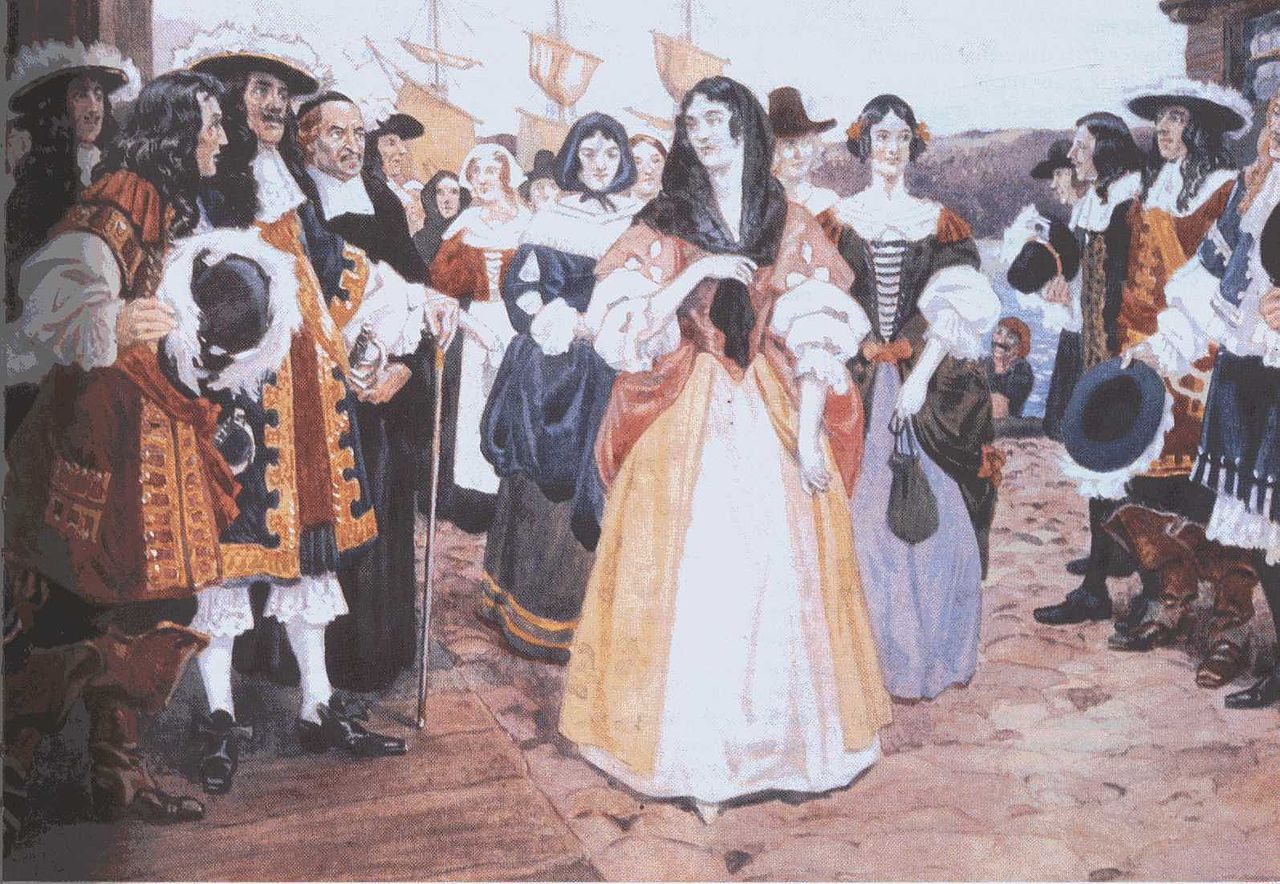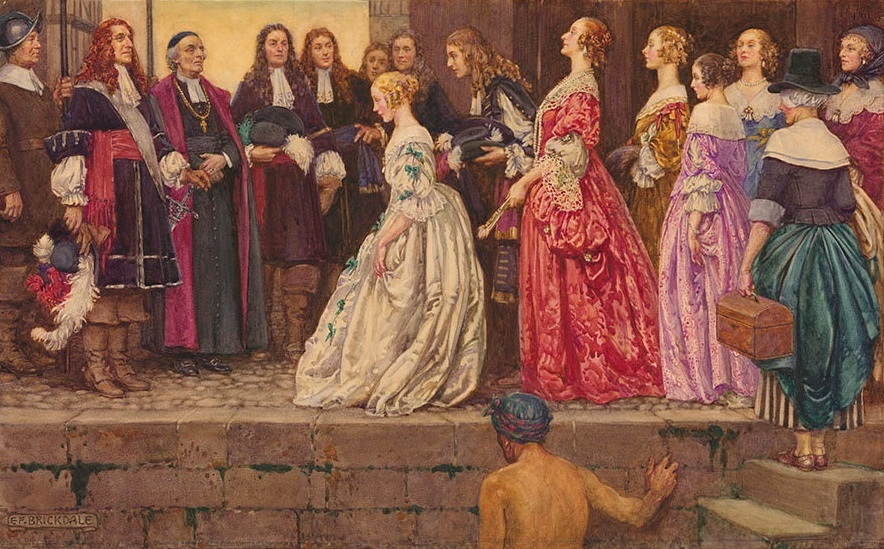Note: Both the Vermette family and the Lalonde family (and actually about 85% of all French Canadian families), are descended from a group of French women recruited by the Jesuits between 1663 and 1673 to sail to the new French colony in North America. The women were needed to ensure the success of France’s colony in competition with the British colonies to the south. The Vermette family is descended directly from Barbe Menard (1653-1685) and the Lalonde family is directly descended from Marie Barbant (1638-1702). Both these women arrived in New France during the peak arrival years of 1668-1670.
April 30 & May 14, 1995 issues of the
Morning Sentinel & Kennebec Daily Journal
From the time of the earliest French colonization of Québec in 1604 until 1663, there were only a handful of families living in that region. The majority of its small population was made up of hunters, trappers, French soldiers, a few explorers, a few priests, and some sailors. France and England, long at odds and in competition with each other, were then attempting to expand their new colonies, to exploit the land and its resources, and to establish stronger and more viable colonies in the New World.
In 1629, the population of Québec, then the only settlement in the present province of Québec, had a resident population of only 21. By 1639, that number had grown to 139 from new settlers and some births. By 1662, the population had increased almost 10-fold to 1,100. By this time, the English colonies in America were growing rapidly. About this time, the French hierarchy decided to adopt a new plan to help establish a stronger and more permanent foothold in its North American colony, which had, by then, expanded to three principle towns on the St. Lawrence River: Québec, Trois Rivières, and Montréal (known as Ville Marie back then). The plan was to encourage single and widowed young women to go to New France (Québec), marry one of the single or widowed Frenchmen there, raise a family, and establish themselves there as permanent colonists. Compared to France, the New World was a harsh place with its lack of amenities, its ever-present danger from rebellious Indians, its harsh winters, and its isolation from the rest of the civilized world. It took a considerable amount of planning, time, and salesmanship on the part of those pursuing this plan to convince young women to take part in this new and risky venture.

The Arrival of the French Girls at Quebec, 1667 by Charles William Jefferys /
Library and Archives Canada (fonds/c010688k) PD
The recruitment program was initiated around 1661 and the recruiters went to a number of cities where there were large orphanages – a good source for potential candidates. Paris and other cities had several such orphanages where conditions, even in comparison with life in that period of time, were deplorable. As an incentive to enlist, the young girls were to be awarded with a gift (dowry) of from 50 French pounds and up. The Royal treasury provided the necessary funds and it was fully supported by the King of France. Thus, these recruits came to be called “les filles du roi” – the King’s daughters. A number of those recruited also had money and property of their own, as much as 3,000 pounds, received as an inheritance from their deceased parents. Fifty pounds was a substantial amount of money in those days. For example, a common laborer would have to work almost a year to make such a sum and a surgeon made from 100 to 150 pounds a year. Thus, many orphaned girls saw this as an opportunity for adventure, money, marriage, and getting out of their situation. Recruited during the eleven years of this program were 414 orphaned girls . From 1663 to 1673 a total of 774 “Filles du Roi” made the journey to New France. The best year was in 1669 when 135 new “Filles du Roi” were enlisted. In 1670, 134 girls took up the cause. A total of 238 were from Paris, 175 from Bourgs, 46 from Rouen, 35 from La Rochelle, and the rest from other towns and cities. Three were from other countries – England, Germany, and Portugal. Some of the girls who were originally recruited went only as far as the port of embarkation such as Dieppe in Normandy. When they saw what they were getting into, their minds quickly changed and withdrew from the “adventure.”

Jean Talon, Bishop François de Laval and several settlers welcome the King’s Daughters upon their arrival. Painting by Eleanor Fortescue-Brickdale.
The first stop in la Nouvelle-France was Québec (city) where most of them disembarked and remained. Shortly after their arrival, the girls were usually escorted to a place where they would meet eligible bachelors, and the rest is history. The number of single girls available to the French men in Québec were few and far between before this program was initiated. Consequently, some of the men married either local Indian girls or daughters of pioneer Québec families. The Church, seeing the need for female companions and wives for the growing number of bachelors in Québec, also supported this program. Within one year of their arrival most of the girls got married and the dowry promised them from the Royal treasury was received.
Some of the King’s Daughters survived as many as four husbands. A few returned to France later on with their husbands. But, most of them remained in New France for the rest of their natural lives. The majority of these girls were “ordinary” in that sense, but a few were so-called “filles de qualité” from the bourgeois class, that is, daughters of business, professional or military officer families. They settled mainly in the Québec (city) area, raised their families, and led a relatively quiet but hard-working life. Very few of these girls became societal problems. Only five ever got into trouble with the courts for reasons of adultery, prostitution, or debauchery. Only one, Marie Quequejeu, widow of Pierre Rivaut, was executed in 1684 by the authorities for a very serious crime (actual records lost). On the same day, her son-in-law, Pierre Doret, a “coureur de bois,” was also executed. Civil and Church laws were very strict at that time. As a whole, these pioneer women faired quite well considering the new and unique obstacles, hardships, and environment they had to face and endure. They surely had to be a very hardy, courageous and resolute group of young ladies.
Every Franco-American with roots in Québec has several of these King’s Daughters as direct ancestors. Thirty-three of these girls are my ancestors from my father’s side, and another thirty-three appear on my mother’s side. Thus, nearly nine percent of the Filles du Roi are my direct ancestors (none of which were the problem ones).
On the lighter side, the reason Québec girls are said to be prettier than those from the Trois Rivières and Montréal areas is that the ships made their first stop at the port of Québec. Consequently, the Québec boys had “first pick.” All the left-overs were sent down-river to the other two settlements. This, of course, is a joke among the folks in Québec city.
